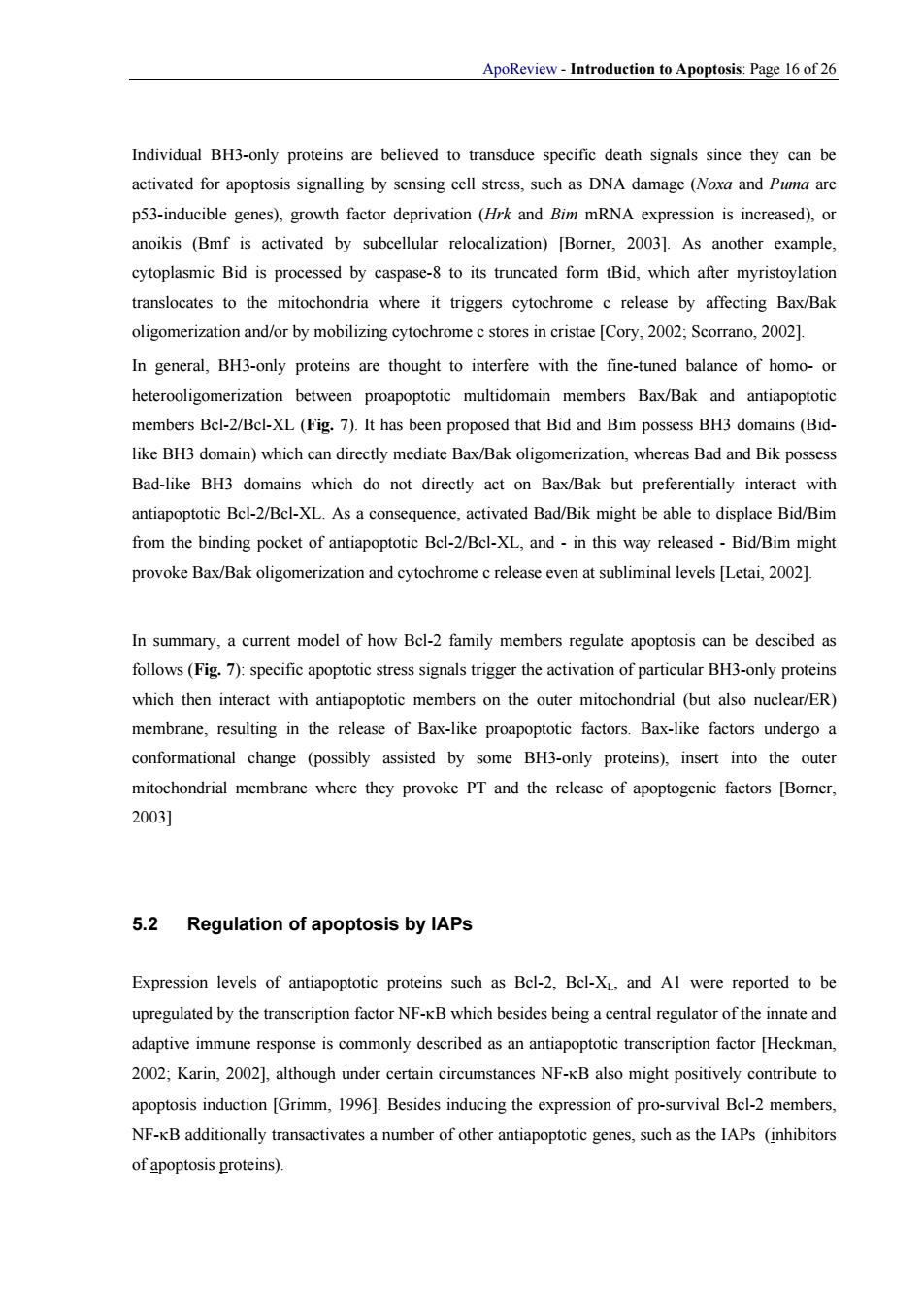正在加载图片...

ApoReview-Introduction to Apoptosis:Page 16 of26 Individual BH3-only proteins are believed to transduce specific death signals since they can be activated for apoptosis signalling by sensing cell stress,such as DNA damage (Noxa and Pa are p53-inducible genes).growth factor deprivation (rk and Bim mRNA expression is increased).or anoikis (Bmf is activated by subcellular relocalization)[Borner,2003].As another example, eytoplasmic Bid is processed by caspase-to its truncated form tBid,which after myristoylation translocates to the mitochondria where it triggers cytochrome c release by affecting Bax/Bak oligomerization and/or by mobilizing cytochrome c stores in cristae [Cory,2002;Scorrano,2002] In general,BH3-only proteins are thought to interfere with the fine-tuned balance of homo-or heterooligomerization between proapoptotic multidomain members Bax/Bak and antiapoptotic members Bcl-2/Bcl-XL(Fig.7).It has been proposed that Bid and Bim possess BH3 domains(Bid- like BH3 domain)which can directly mediate Bax/Bak oligomerization,whereas Bad and Bik possess Bad-like BH3 domains which do not directly act on Bax/Bak but preferentially interact with antiapoptotic Bel-2/Bel-XL.As a consequence,activated Bad/Bik might be able to displace Bid/Bim from the binding pocket of antiapoptotic Bcl-2/Bcl-XL,and-in this way released-Bid/Bim might provoke Bax/Bak oligomerization and even at subliminal levels [Letai,002] In summary,a current model of how Bcl-2 family members regulate apoptosis can be descibed as follows(Fig.7):specific apoptotic stress signals trigger the activation of particular BH3-only proteins which then interact with antiapoptotic members on the outer mitochondrial (but also nuclear/ER) membrane.resulting in the release of Bax-like proapoptotic factors.Bax-like factors undergo a conformational change (possibly assisted by some BH3-only proteins),insert into the outer mitochondrial membrane where they provoke PT and the release of apoptogenic factors [Borer, 2003] 5.2 Regulation of apoptosis by IAPs Expression levels of antiapoptotic proteins such as Bcl-2.Bel-X and Al were reported to be upregulated by the transcription factor NF-KB which besides being a central regulator of the innate and adaptive immune response is commonly described as an antiapoptotic transcription factor [Heckman, 2002:Karin,2002]although under certain circumstances NF-kB also might positively contribute to apoptosis induction [Grimm,196].Besides inducing the expression of pro-survival Bcl-2 members. NF-B additionally transactivates a number of other antiapoptotic genes.such as the IAPs (inhibitors of apoptosis proteins). ApoReview - Introduction to Apoptosis: Page 16 of 26 Individual BH3-only proteins are believed to transduce specific death signals since they can be activated for apoptosis signalling by sensing cell stress, such as DNA damage (Noxa and Puma are p53-inducible genes), growth factor deprivation (Hrk and Bim mRNA expression is increased), or anoikis (Bmf is activated by subcellular relocalization) [Borner, 2003]. As another example, cytoplasmic Bid is processed by caspase-8 to its truncated form tBid, which after myristoylation translocates to the mitochondria where it triggers cytochrome c release by affecting Bax/Bak oligomerization and/or by mobilizing cytochrome c stores in cristae [Cory, 2002; Scorrano, 2002]. In general, BH3-only proteins are thought to interfere with the fine-tuned balance of homo- or heterooligomerization between proapoptotic multidomain members Bax/Bak and antiapoptotic members Bcl-2/Bcl-XL (Fig. 7). It has been proposed that Bid and Bim possess BH3 domains (Bidlike BH3 domain) which can directly mediate Bax/Bak oligomerization, whereas Bad and Bik possess Bad-like BH3 domains which do not directly act on Bax/Bak but preferentially interact with antiapoptotic Bcl-2/Bcl-XL. As a consequence, activated Bad/Bik might be able to displace Bid/Bim from the binding pocket of antiapoptotic Bcl-2/Bcl-XL, and - in this way released - Bid/Bim might provoke Bax/Bak oligomerization and cytochrome c release even at subliminal levels [Letai, 2002]. In summary, a current model of how Bcl-2 family members regulate apoptosis can be descibed as follows (Fig. 7): specific apoptotic stress signals trigger the activation of particular BH3-only proteins which then interact with antiapoptotic members on the outer mitochondrial (but also nuclear/ER) membrane, resulting in the release of Bax-like proapoptotic factors. Bax-like factors undergo a conformational change (possibly assisted by some BH3-only proteins), insert into the outer mitochondrial membrane where they provoke PT and the release of apoptogenic factors [Borner, 2003] 5.2 Regulation of apoptosis by IAPs Expression levels of antiapoptotic proteins such as Bcl-2, Bcl-XL, and A1 were reported to be upregulated by the transcription factor NF-κB which besides being a central regulator of the innate and adaptive immune response is commonly described as an antiapoptotic transcription factor [Heckman, 2002; Karin, 2002], although under certain circumstances NF-κB also might positively contribute to apoptosis induction [Grimm, 1996]. Besides inducing the expression of pro-survival Bcl-2 members, NF-κB additionally transactivates a number of other antiapoptotic genes, such as the IAPs (inhibitors of apoptosis proteins)